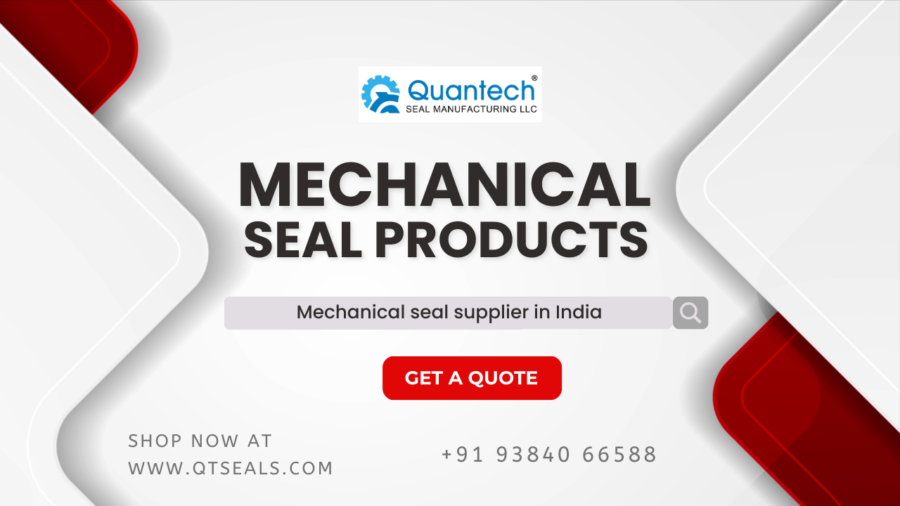
Mechanical Seal Supplier in India
Quantech Sealing Systems is the leading Mechanical Seal Supplier in India. Mechanical seals are devices used to prevent the leakage of fluids, such as liquids or gases, from rotating machinery, such as pumps, compressors, and mixers. They are commonly used in various industries to maintain a secure and leak-free environment for processes involving liquids or gases. Mechanical seals play a crucial role in maintaining equipment efficiency, reducing maintenance needs, and preventing environmental contamination.
Key features and components of mechanical seals
Primary Components
Rotating Face: One part of the mechanical seal that rotates along with the shaft of the equipment.
Stationary Face: The other part of the mechanical seal that remains stationary and is attached to the equipment housing.
Sealing Elements
Sealing Faces: The rotating and stationary faces are precision machined surfaces that come into contact to create a seal. These faces are often made of materials such as carbon, ceramic, or tungsten carbide.
Secondary Sealing Elements:
O-rings or Gaskets: These provide secondary sealing and prevent leakage along the seal faces. They are made from elastomeric materials like rubber or fluorocarbon.
Springs:
Elastomer Springs: These are used to maintain consistent contact between the sealing faces despite any wear or axial movement of the shaft.
Metal Parts
Metal Components: Mechanical seals often include metal components like retainers, glands, and drive pins to hold the seal in place and ensure proper operation.
Flush and Quench Ports:
Flush Port: Some mechanical seals have a flush port to provide a controlled flow of clean fluid between the sealing faces, which helps to prevent the buildup of contaminants and debris.
Quench Port: In applications with high-temperature fluids, a quench port can be used to introduce a cooler fluid to control the temperature at the seal faces.
Barrier Fluids
Barrier Fluids: These are lubricating fluids introduced between the sealing faces to reduce friction and heat generation. They also provide a barrier against the process fluid, preventing it from leaking out.
Applications
Pumps: Mechanical seals are commonly used in centrifugal pumps, reciprocating pumps, and other types of pumps.
Compressors: They are used in various types of compressors, including reciprocating and rotary screw compressors.
Mixers and Agitators: Mechanical seals are also found in mixers and agitators used in industries like chemicals and pharmaceuticals.
Types of mechanical seals
There are several types of mechanical seals available, each designed to suit specific applications, operating conditions, and industry requirements. Here are some common types of mechanical seals:
Single Mechanical Seal
This is the most basic type of mechanical seal, consisting of two sealing faces, one stationary and one rotating. It is used in applications with moderate pressure and temperature conditions.
Double Mechanical Seal
Also known as a dual mechanical seal, this type features two sets of sealing faces with a barrier fluid in between. It offers higher reliability and is often used in applications with hazardous or toxic fluids.
Cartridge Mechanical Seal
A pre-assembled unit that includes all the necessary components, such as sealing faces, springs, and gland plates. Cartridge seals are easier to install and provide consistent performance.
Balanced Mechanical Seal
Designed to handle high-pressure applications, a balanced mechanical seal uses a mechanism to reduce the force on the sealing faces, making it suitable for pumps with high differential pressures.
Unbalanced Mechanical Seal
This type is used when the pressure difference across the seal is not too high. It has a simpler design and is often used in applications with lower pressure requirements.
Pusher Mechanical Seal
This design includes a dynamic secondary seal that moves with the rotating seal face. It accommodates axial movement of the shaft and is commonly used in applications with equipment misalignment.
Non-Pusher Mechanical Seal
In this type, the dynamic secondary seal is stationary. It’s used when axial movement of the shaft is minimal and offers simpler construction.
Metal Bellow Mechanical Seal
Utilizes a metal bellows as the secondary sealing element. It accommodates axial movement and is often used in applications with high temperature variations.
Elastomer Bellow Mechanical Seal
Similar to the metal bellow seal, but it uses an elastomeric bellows instead. It’s suitable for applications where chemical compatibility is important.
Split Mechanical Seal
A type of mechanical seal that can be split into two halves for easier installation without the need to disassemble the equipment.
Gas-lubricated Mechanical Seal
Uses a controlled flow of gas (such as nitrogen) as the barrier medium between the sealing faces, suitable for high-speed and high-temperature applications.
Dry Running Mechanical Seal
Dry Running seals designed to operate without any external lubrication, these seals are used in applications where traditional lubricants cannot be used.
It’s important to select the right type of mechanical seal based on factors like the type of fluid, operating temperature and pressure, equipment alignment, and specific industry requirements. Consulting with experts or manufacturers can help you choose the most suitable mechanical seal for your application.

